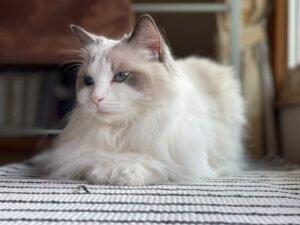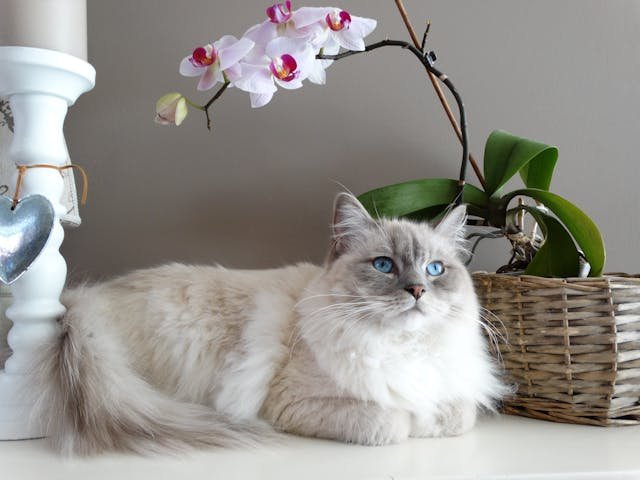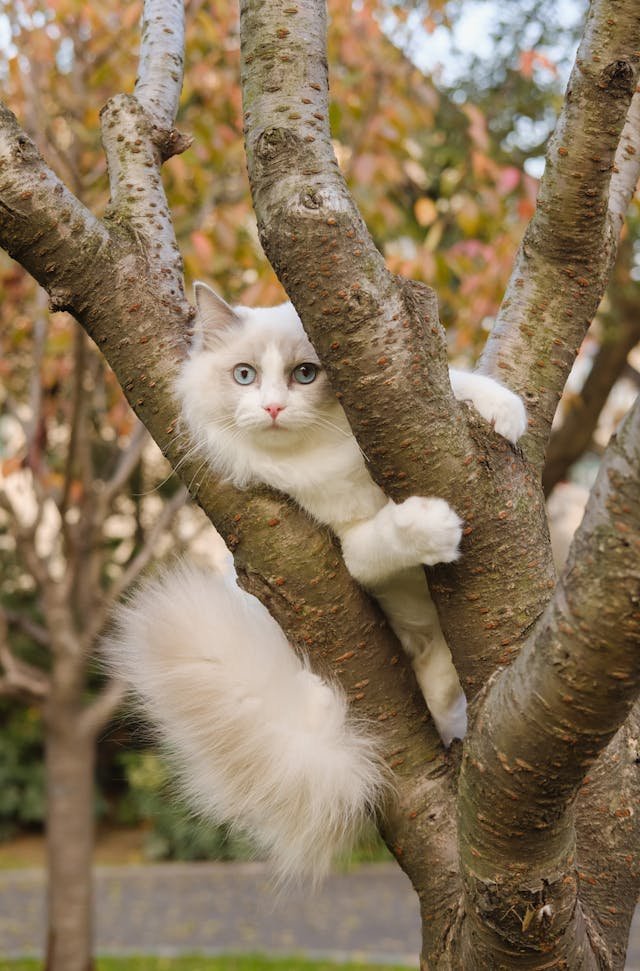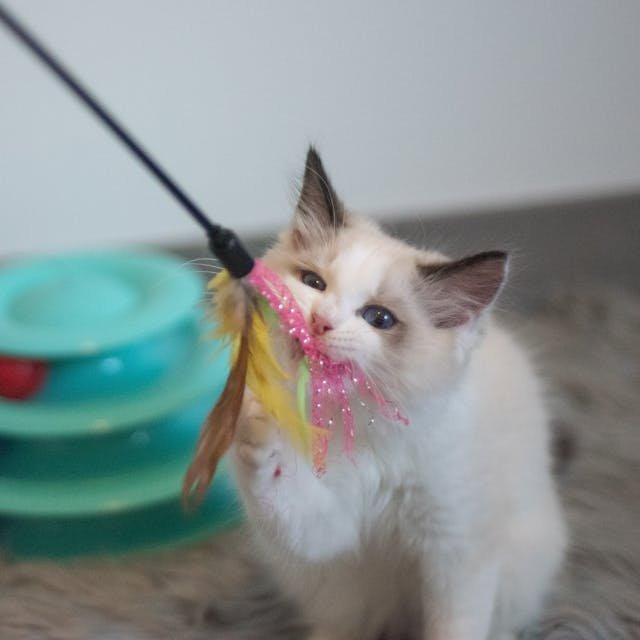
The Lilac Point Ragdoll is one of the rarest and calmest cat breeds in the world. It has soft, silky fur, a white body, and light pinkish-grey points on the ears, face, tail, and legs. These cats also have deep blue eyes that make them look peaceful and beautiful. Many people in the USA love this cat because of its quiet nature, gentle behavior, and lovely appearance. It’s a perfect cat for homes, especially for families, seniors, or people living in small apartments.
In this guide, you’ll learn everything about the Lilac Point Ragdoll. From how it looks, acts, grows, and eats to how to take care of it, this guide will help you understand the breed fully. We’ll also cover different types like Mitted Lilac Ragdoll, Lilac Bicolor Ragdoll, and Lilac Mink Ragdoll, and show you how they are different from other Ragdoll cats like the Blue Point.
Lilac Point Ragdoll – A Rare Beauty in the Ragdoll Family

Lilac Point Ragdolls have a beautiful mix of soft cream and pink-grey colors. Their fur is long, silky, and smooth. The color on their ears, tail, and paws is light grey with a hint of pink or purple. These colors come from a rare genetic trait called coat color dilution. It makes the chocolate color lighter and gives them their special look.
They are not just pretty. These cats are also sweet, loving, and relaxed. They like to be around people and enjoy cuddles. Their calm personality is known as the Ragdoll breed temperament. They don’t jump around or make a lot of noise. They love to sit with you, follow you around, and sleep in warm corners. Because of their peaceful behavior, they are a great choice for indoor homes and small living spaces.
What Does a Lilac Point Ragdoll Look Like? Coat, Eyes & Traits

Lilac Point Ragdolls are large cats with soft, long fur. Their body is mostly white or cream, and the points on their face, ears, tail, and feet are light pink-grey. Their blue eyes are bright and almond-shaped, which gives them a sweet and gentle look. The fur on their chest and belly is fluffy, and the tail is full and long.
They grow slowly. When they are born, they are pure white. Their color points start to show after a few weeks and fully develop by one year. These cats are strong but feel light when held. They walk slowly and gently. Their appearance makes them part of the group known as soft-coated cat breeds. They are also one of the most beautiful types in the Ragdoll cat color variations list.
Cat Coat Color Dilution Explained
The pink-grey color on Lilac Points comes from a special mix of genes. These genes lighten the usual chocolate color, creating a soft and rare look. This process is called cat coat color dilution, and it is what makes Lilac Points so special and hard to find.
Lilac Point Ragdoll vs Blue Point – What’s the Real Difference?
It’s easy to confuse a Lilac Point with a Blue Point Ragdoll. Both have blue eyes and soft fur. But if you look closely, you’ll see the difference. Blue Points have cooler grey colors, while Lilac Points are warmer and softer in tone. Lilac Points also have a more creamy look, especially on the body.
The Blue Point is more common, but Lilacs are rare. The soft pinkish tone in Lilacs makes them look more elegant. Both have the same loving nature, so choosing between them depends on the color you prefer. In short, Lilac Points are lighter, creamier, and rarer than Blue Points.
Ragdoll Cat Color Variations Table
| Type | Body Color | Point Color | Rarity |
|---|---|---|---|
| Seal Point | Cream | Dark brown | Common |
| Blue Point | Light grey | Slate grey | Common |
| Chocolate Point | Ivory | Cocoa brown | Uncommon |
| Lilac Point | White cream | Pink-grey | Very rare |
| Red Point | Pale body | Orange-red | Rare |
| Cream Point | Off-white | Pale cream | Very rare |
Lilac Point Ragdoll Personality – Calm, Gentle, and Family-Friendly
Lilac Point Ragdolls are friendly, quiet, and very easy to live with. They love to be close to their people. They will follow you from room to room, sit on your lap, or lie next to you while you relax. They don’t jump or run a lot. Instead, they like calm places and soft voices. This makes them a perfect match for kids, seniors, or anyone who wants a peaceful cat.
They are very smart and know when you are happy or sad. Many owners say their Lilac Point sits beside them during hard times or waits by the door when they come home. These cats are full of love. They are perfect examples of good indoor cat behavior, always staying close and never causing trouble.
Ragdoll Cat Personality Traits
Ragdolls are social, quiet, and easy to handle. They don’t scratch furniture and love being near people. They are often called “puppy cats” because of how loyal they are.
Understanding the Genetics Behind Lilac Point Ragdoll Coloring
Lilac color in Ragdolls comes from two special genes. One gene gives the chocolate color. The other gene makes that color lighter. When both genes come together, they create the rare lilac tone. It is not easy to breed a Lilac Ragdoll, which is why they are rare and more expensive.
The color doesn’t show up right away. Lilac Ragdoll kittens are born white. Their true color starts showing after a few weeks and gets stronger by the time they are a year old. That’s why some kittens may look like Blue Points at first. Good breeders in the USA often use DNA testing to confirm if the kitten is a true Lilac.
Soft-Coated Cat Breeds and Their Inheritance
Lilac Ragdolls belong to the group of soft-coated cat breeds. Their soft fur comes from generations of careful breeding. The fur is not only soft but also lies flat and smooth.
Different Types of Lilac Ragdolls – Bicolor, Mitted, Mink & More
Lilac Point Ragdolls don’t all look the same. There are different types, each with special markings. The most common types include the Mitted Lilac Ragdoll, Lilac Bicolor Ragdoll, and Lilac Mink Ragdoll. A Mitted Lilac Ragdoll has white paws like tiny mittens, a white chin, and a white stripe on its belly. These cats look sweet and neat. Their lilac points stay on their ears, tail, and face, but the mittens make them stand out.
The Lilac Bicolor Ragdoll has a white “V” shape on its face. Its chest, belly, and legs are also white. The lilac color stays on the ears and tail. Bicolors are very photogenic and have an elegant look. The Lilac Mink Ragdoll is even more special. It has a richer, warmer tone and sometimes has aqua-colored eyes instead of blue. The coat is softer and thicker, almost like velvet. This type is not accepted in cat shows, but many people love them as pets.
Mitted Lilac Ragdoll
The mitted version is charming and clean-looking. It’s loved by families because of its cute paws and soft personality.
How Lilac Point Ragdolls Compare to Other Ragdoll Colors
All Ragdolls are beautiful, but Lilac Points have a special, soft glow. They are the lightest of all the colors. Their pinkish-grey points and creamy body give them a peaceful, fairy-tale look. Compared to Seal Points, which are dark brown, or Blue Points, which are grey, Lilacs look warmer and more delicate. They are also one of the most expensive types because they are harder to breed.
Even though their look is unique, their behavior is similar to all Ragdolls. They are sweet, loving, and easy to train. Their Ragdoll cat personality traits include loyalty, calmness, and a need to be close to their family. They don’t mind staying indoors and are happy in small homes or apartments.
Rare Ragdoll Cat Types
Lilac is one of the rarest Ragdoll colors. Other rare types include red and cream. These colors need special parents and careful breeding.
Lilac Point Ragdoll Kittens – What to Expect From Birth to 1 Year
Lilac Point kittens are born white. You won’t see any color on them at first. After a few weeks, you may notice light grey or lavender on the ears and tail. The color gets stronger as they grow, but full color doesn’t appear until they are around one year old. That’s why it’s hard to know if a kitten is truly lilac in the early weeks.
These kittens are very calm and love being touched. They are playful but not wild. During their Ragdoll kitten development, they form strong bonds with their owners. If you feed them well and groom them gently, they grow into peaceful and lovely adult cats. They learn routines easily and enjoy soft beds, slow games, and staying near people.
Ragdoll Kitten Development Timeline
| Age | Stage & Milestones |
|---|---|
| 0–4 weeks | Pure white, feeding from mother |
| 5–8 weeks | Soft color points start to show |
| 3 months | More energy, bonding with humans |
| 6 months | Bigger body, thicker coat, eye clarity |
| 1 year | Full lilac color and adult behavior |
Grooming a Lilac Point Ragdoll – Coat Care Made Easy
Lilac Point Ragdolls have silky fur that does not tangle easily. Still, they need brushing at least two or three times a week. Use a slicker brush or metal comb. This keeps their coat clean and soft. Regular brushing also prevents hairballs and helps you bond with your cat. It’s best to start grooming them when they’re young so they get used to it.
Along with brushing, clip their nails every two or three weeks. Check their ears and clean them if needed. Also, brush their teeth or use dental treats to keep their mouth healthy. Because they are part of soft-coated cat breeds, they need care to keep their beautiful coat in good condition. Regular grooming helps them feel fresh and loved.
Long-Haired Cat Grooming Routine
Brush gently, focus behind the ears and under the legs. These areas get tangled the most. Make grooming a calm and happy time.
Best Diet for a Lilac Point Ragdoll Cat – What to Feed & Avoid
To keep your Lilac Point Ragdoll healthy and happy, feed them high-quality food with plenty of protein. Look for food that includes taurine and omega-3, which help their heart and coat. Wet food is good too—it adds moisture and helps prevent urinary problems. Avoid foods with corn, wheat, or artificial flavors. These can upset their stomach and make their coat dull.
Since Ragdolls don’t move a lot, they can gain weight easily. It’s important to control portions and avoid giving too many treats. Follow your vet’s advice for feeding amounts. A balanced Ragdoll cat diet helps keep their fur shiny, their body strong, and their energy steady.
Preventing Obesity in Indoor Cats
Feed on schedule and play a little every day. Use food puzzles or toss kibble across the floor to make mealtime more active.
Do Lilac Point Ragdolls Make Good Pets for American Families?
Yes, Lilac Point Ragdolls are one of the best cats for families in the USA. They are loving, gentle, and peaceful. They don’t scratch, don’t run wild, and love staying close to people. They are easy to care for and don’t need large homes or gardens. Even people living in small apartments can keep them happy.
They’re great with children and friendly with other pets. They enjoy a quiet home where they feel safe. These cats are perfect for people who want a soft, cuddly pet that stays calm and relaxed. Their gentle ways make them a great fit for almost any home.
Best Cats for Apartment Living
Lilac Point Ragdolls don’t need much space. Just a soft bed, a quiet home, and someone to love.
How to Spot a Purebred Lilac Point Ragdoll – Signs and Testing
To know if a Lilac Point Ragdoll is purebred, look at its color, fur, and eyes. The points should be pinkish-grey. The coat should be soft, long, and silky. The eyes must be deep blue. Purebred Ragdolls are also large and gentle in behavior. But looks aren’t always enough. For full proof, ask the breeder for registration papers and health tests.
Groups like The International Cat Association (TICA) and Cat Fanciers’ Association (CFA) give certificates to trusted breeders. Always choose a breeder that follows their rules. If you’re not sure, ask for a DNA test. It can tell you if the cat is truly a Lilac Point Ragdoll.
Role of CFA & TICA
These organizations make sure breeders follow health and breed standards. A certified kitten is a safe and smart choice.
Lilac Point Ragdoll Health Concerns – What Owners Should Know
Lilac Point Ragdolls are usually healthy, but like all cats, they can get sick. One common problem is Hypertrophic Cardiomyopathy (HCM), a heart disease that affects some Ragdolls. Good breeders test for this before selling kittens. You should always ask about this test when buying a kitten.
Other health risks include obesity and urinary problems. You can prevent most of these by feeding them good food, playing with them every day, and taking them to the vet once a year. With proper care, most Lilac Point Ragdolls live for 15 years or more. They offer quiet love and comfort for a long time.
Hypertrophic Cardiomyopathy (HCM) Risk
Ask your breeder if both parents were tested. A healthy heart means a long, happy life for your cat.
Where to Find a Lilac Point Ragdoll in the USA – Breeders & Rescues
Because Lilac Point Ragdolls are rare, not every breeder offers them. Start by finding breeders who are registered with TICA or CFA. These breeders care about health and breed standards. Expect to pay between $900 and $2,000 depending on the breeder, location, and cat’s quality.
If you want to adopt, check rescue websites like Adopt-a-Pet or Petfinder. Some breeders also rehome adult cats when they retire them from breeding. Never buy from a seller who refuses to show real photos, health tests, or registration papers. A real Lilac Ragdoll breeder USA will always answer your questions and invite you to meet the kittens.
Trusted Lilac Ragdoll Breeders USA
Choose breeders with good reviews, clean homes, and real paperwork. Don’t rush—wait for the right cat.
Why Lilac Point Ragdolls Are Among the Most Elegant Cat Breeds
The Lilac Point Ragdoll is calm, kind, and beautiful. Its soft coloring, bright eyes, and gentle nature make it a top choice for cat lovers in the USA. These cats are easy to care for and love to be close to their people. They are loyal, quiet, and full of love.
Thanks to Ann Baker, who created the Ragdoll breed in the 1960s, we now have this special cat. Her goal was to make a cat that looks like a doll but behaves like a friend. The Lilac Point Ragdoll is the result of that dream—soft, sweet, and always by your side.
The Legacy of Ann Baker
Ann Baker gave the world a gentle, loyal, and beautiful cat. The Lilac Point Ragdoll carries her dream forward.
FAQs: About Lilac Point Ragdoll Cats
1:Are Lilac Point Ragdolls rare?
Yes, Lilac Point Ragdoll are considered rare ,particularly in the US.
2:Do Lilac Ragdolls have blue eyes?
True Lilac Points have deep blue eyes. Minks and Sepias may have aqua or green eyes.
3:How do I know if my Ragdoll is a Lilac Point?
Look for pale grey-pink points and a white body. DNA tests can also confirm it.
4:Are Lilac Ragdolls good indoor cats?
Yes, they’re calm and love indoor life. They are great for quiet homes and apartments.
5:What is the lifespan of a Lilac Point Ragdoll?
They usually live 12 to 15 years. Regular vet care helps them stay healthy longer.
Conclusion: Is a Lilac Point Ragdoll Right for You?
If you want a rare, peaceful, and loving cat that fits perfectly in a calm home, the Lilac Point Ragdoll is ideal. Its beauty, sweet nature, and gentle soul make it worth every effort—especially if you’re tired of noisy, needy pets.

